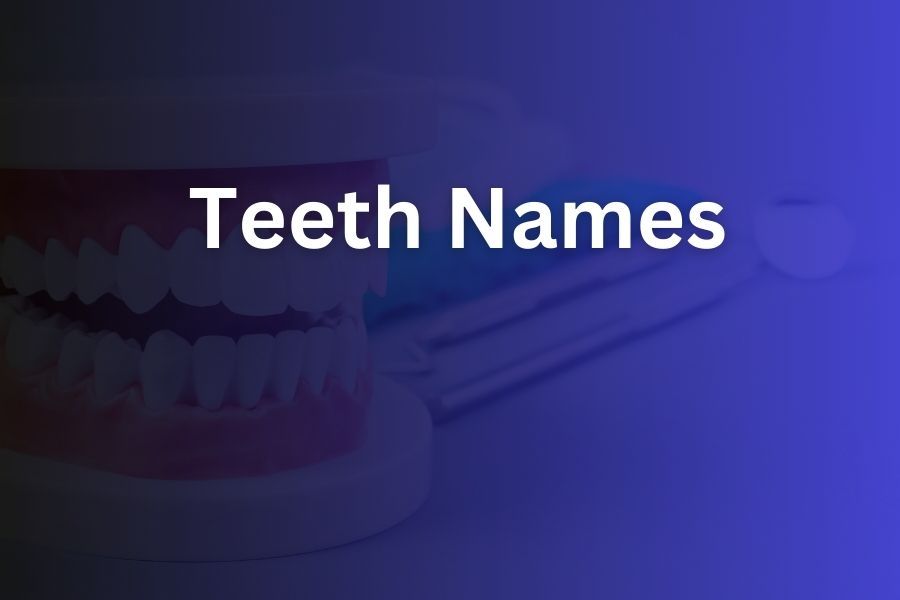Your mouth contains many teeth, each with a specific name and job. Knowing those names helps you understand oral care and dental visits, and helps you talk confidently with professionals.
In this article, you will learn what each tooth is called, where it sits in your mouth, how it functions, and how to care for them properly.
What Are the Major Types of Teeth
First, let’s look at the four major types of adult teeth: incisors, canines, premolars, and molars.
Incisors
Incisors are the front eight teeth (four upper, four lower).
They have thin, sharp edges.
Their main job is to bite into food.
You typically use them to take the first bite of something like an apple or a sandwich.
Canines
Next to the incisors sit the canines (also called cuspids).
You have four canines in a full adult set—one in each upper and lower quadrant.
They are pointed and strong, designed to tear food.
They also help guide jaw movement when you close your mouth and play a role in your facial structure.
Premolars
Behind the canines are the premolars (also called bicuspids).
Adults usually have eight premolars—two in every quadrant.
They have flat surfaces with ridges to help crush food and prepare it for grinding.
Children do not have premolars in their primary (baby) teeth set.
Molars (Including Wisdom Teeth)
Molars sit at the back of your mouth.
An adult typically has twelve molars: three per quadrant including wisdom teeth (third molars).
Their job is to grind and chew food thoroughly.
Because they sit deep within the jaw, accessing them for cleaning can be harder, and they often are more prone to decay or complications.
Primary (Baby) Teeth vs Permanent Teeth
When you were a child you had a different set of teeth: your primary teeth.
Children normally have 20 primary teeth: eight incisors, four canines, and eight molars.
Most primary teeth appear by age three and begin falling out around age six to make way for permanent teeth.
By around age 21 most people have their full adult set (if wisdom teeth come in).
Detailed Overview of Teeth Names and Positions
Here is a clearer breakdown of names and numbers so you know exactly which tooth is which.
Upper jaw vs lower jaw: each quadrant has the same types of teeth.
– Central incisor: The middle front tooth in each quadrant.
– Lateral incisor: Next to the central incisor.
– Canine (cuspid): Next to the lateral incisor.
– First premolar (adult only): Positioned behind the canine.
– Second premolar (adult only): Located just behind the first premolar.
– First molar: The first large grinding tooth behind the premolars.
– Second molar: Next to the first molar.
– Third molar (wisdom tooth): Farthest back, often removed or absent.
Function and Importance of Each Type
Each tooth type has a purpose in chewing, speech, and jaw alignment.
– Incisors: Cut food, support lip function, influence appearance of smile.
– Canines: Tear food, maintain alignment of other teeth, support bite force.
– Premolars: Transition from tearing to grinding, support chewing process.
– Molars: Do most of the heavy work of grinding food into digestible size. They also help maintain the height of your bite and support your jaw.
When one type of tooth fails or is missing this affects the entire chewing system.
Special Focus: Wisdom Teeth (Third Molars)
Wisdom teeth are the final molars to appear, usually between ages 17 and 25.
Many people don’t have room in their jaws for them or they grow at odd angles.
They may become impacted (unable to fully erupt) or cause crowding, pain, or infection.
Because of that, removal of wisdom teeth is common in the U.S.
Teeth Naming and Numbering Systems
Dentists use numbering systems to identify teeth precisely.
One common system is the Universal Numbering System where adult teeth are numbered 1 through 32.
In that system: Tooth #1 is the upper right third molar (wisdom tooth), #16 is the upper left third molar, #17 is the lower left third molar, and #32 is the lower right third molar.
Primary teeth are labelled A through T in that same system.
Knowing which number or letter your dentist refers to helps you understand your chart and treatment plan.
Recent Stats and Facts
According to recent dental data, most adults have between 28 and 32 permanent teeth.
About 5 percent of people are born without one or more wisdom teeth.
Decay affects molars more than any other teeth type because of their deep grooves and position.
Around 90 percent of chewing in adults is done by molars and premolars combined.
Why You Should Know Teeth Names
Being familiar with teeth names empowers you as a patient.
When your dentist says “we need to restore the upper left first molar” you know exactly which tooth they refer to.
You understand treatment discussions, insurance code questions, and oral hygiene needs.
Teaching children tooth names helps them take ownership of their dental hygiene.
Tips for Caring for All Your Teeth
Here are solid habits you should adopt:
• Brush twice a day using fluoride toothpaste, making sure to reach the back molars.
• Floss daily to clean between teeth, especially between canines and premolars where food may get stuck.
• Visit your dentist at least twice a year for check-ups and cleaning.
• Consider sealants for deep grooves in premolars and molars to reduce decay risk.
• Discuss wisdom-teeth monitoring with your dentist starting in your late teens.
• Avoid sugary snacks, limit soda, and drink plenty of water to protect enamel.
• Use a mouthguard during contact sports to protect front teeth like incisors and canines.
Signs of Trouble to Watch
Certain symptoms mean you should see a dentist sooner rather than later:
• Sharp pain or sensitivity in a specific tooth when biting or exposed to hot/cold.
• Visible dark spots or pits on molars or premolars.
• Swelling or infection near a wisdom tooth.
• Gaps or shifting of teeth after losing one, which affects alignment of other teeth.
• A front tooth (incisor) cracked or chipped – this can affect your smile and speech.
How Teeth Names Matter in Treatment
When you undergo dental work the correct tooth name is essential.
For example, only the premolars might get a crown if they are fractured, not the molars.
Orthodontic treatments often focus on correcting alignment of canines and premolars because they guide chewing mechanics.
If a wisdom tooth is impacted, removing it prevents damage to second molars.
Knowing names helps you ask informed questions, track your treatment pricing, and understand your dental chart.
Maintenance Through Life Stages
In childhood you care for baby teeth (primary incisors, canines, molars) while permanent teeth form underneath.
In adolescence premolars and permanent molars erupt and need special care.
In adulthood you deal with lifetime wear, possible gum recession, and if you have wisdom teeth the potential removal.
In older age you may face missing teeth, bridges, implants and should preserve the remaining teeth by caring for them well.
Conclusion
Understanding the names of teeth gives you clearer insight into how your mouth works, how to care for it, and how to speak confidently about your dental health.
From incisors to wisdom teeth each type has a specific role.
You now know their names, positions, functions, and how to look after them through life’s stages.
Use this knowledge to ask better questions, stay proactive in your oral care, and support a healthy smile for years to come.
FAQ’s
- How many types of teeth are there in an adult mouth?
Adults typically have four types: incisors, canines, premolars and molars (including wisdom teeth). - What do we call the pointed teeth next to the incisors?
Those are called canines (or cuspids), and their function is to tear food and guide your bite. - Why do children have fewer types of teeth?
Children’s primary teeth exclude premolars and wisdom teeth. Their set includes incisors, canines and molars until permanent teeth replace them. - What are wisdom teeth and why are they named that?
Wisdom teeth are the third molars that erupt in late teens or early twenties. They carry that name because they appear as you “grow up” into adulthood. - How does knowing your tooth names help when you see a dentist?
It helps you understand which tooth is being discussed (for example upper left first molar), understand treatment plans and communicate clearly with the dentist. - Which teeth do most of the chewing work?
Molars (and premolars) perform most chewing and grinding work because of their wide and flat surfaces located at the back of the mouth. - What special care do molars and wisdom teeth need?
Molars need careful cleaning because deep grooves trap food. Wisdom teeth often need monitoring or removal due to eruption issues, crowding or impact.










